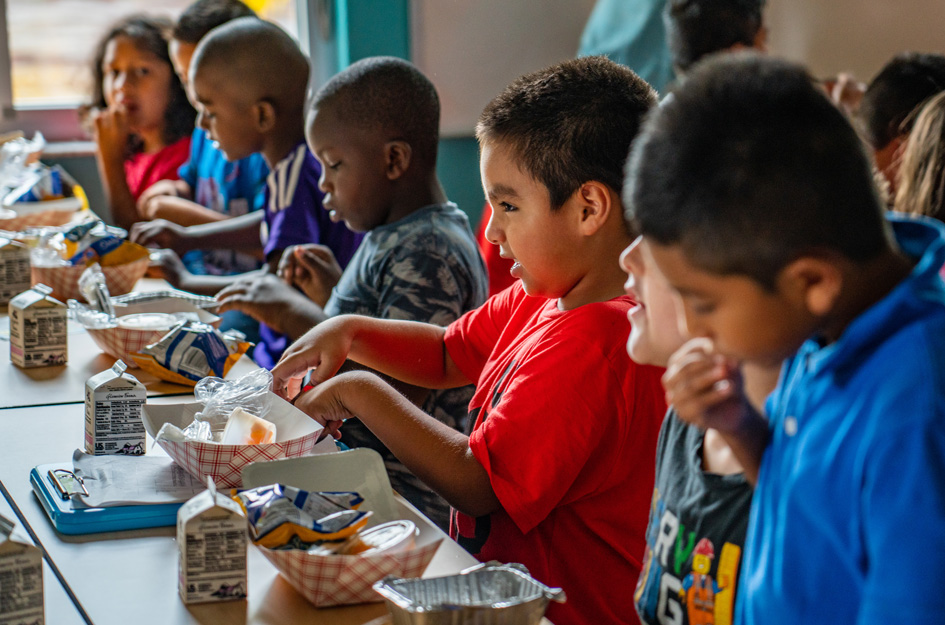When young people have access to healthy meals and snacks, they’re able to focus on whatever comes their way – a STEM experiment, an impromptu game of basketball, raising their hand to speak up on a topic they care about, being there for a friend.
However, food insecurity threatens the wellbeing of millions of kids and teens each year, and due to systemic inequities, food insecurity disproportionately impacts those who identify as Black, Indigenous and people of color. According to Feeding America, 1 in 6 children experience food insecurity.
Every day, Boys & Girls Clubs keep kids fed, fueled and focused. Clubs run local snack and meal programs to ensure kids have access to nutritious food afterschool and during the summer. That way kids can focus on their day, and not where their next meal is coming from.
What is food insecurity?
Food insecurity is the lack of financial resources to supply food within a household. While food insecurity can impact people living above or below the poverty line, it is closely associated with poverty. High-poverty areas are also linked to a lack of affordable, healthy foods. A “food desert” is an area where accessing healthy food, especially fresh produce, can be a challenge.
Fruits and vegetables are an essential part of nutrition, especially for kids’ growth and development, but families living in food deserts face additional hurdles to accessing healthy food, including limited healthy good options, prevalence of “convenience” food in their area, transportation challenges, high food costs and income inequality.
While grocery and meal programs and services exist to support these families, there’s no easy solution. For instance, the need for groceries and meals was dire at the start of the coronavirus pandemic as many services and programs that families depend on shut down. And while many of those systems are back up and running, the need for reliable meals continues to grow due to the pandemic’s effects as well as increasing food costs due to inflation.
Each year, summertime is often a time of struggle for families experiencing food insecurity. With schools closed, free and reduced-priced breakfast and lunch programs are no longer keeping kids fed with reliable, daily meals.
What are the impacts of food insecurity on kids?
Kids and teens who aren’t sure where their next meal is coming may have difficulty focusing on schoolwork. They may be embarrassed or unsure how to talk about getting something to eat and isolate themselves from adults and peers. And their hunger and worry may show up in their behavior, attitude and actions.
Household food insecurity can also have a number of long-term health consequences, both in a child’s physical health and development, and their social-emotional health, with food insecurity potentially creating trauma in the life of a young person.
How Clubs reach hungry kids when school is out
About 60% of Boys & Girls Club members qualify for free or reduced-priced school lunches.
When school is out, Clubs are in – and that means snacks and meals that kids and teens can rely on. In fact, in 2019, 92% of Clubs reported serving more than 95 million meals and snacks at no cost to members, thanks to our partnership with the U.S. Department of Agriculture and other local partners.
Especially during the summer and in food deserts, these site-based meal programs serve a critical need in communities. In addition to providing healthy meals, during the summer months Clubs provide safe places, stop summer learning loss through educational programs and keep kids active.
Over the pandemic, Club meal and snack programs proved essential for communities across the nation:
Many of these services and meal programs were so impactful that they’ve since been incorporated into standard Club operations as families came to rely on Clubs for access to meals and more.
Food insecurity continues to be a concern for many communities, and Clubs are working to be part of the solution by building partnerships and programs that get dinner on the table and groceries in the fridge for the youth they serve.
Help Clubs keep kids fueled, fed and focused
Boys & Girls Clubs provide young people with meals, mentors and meaningful life experiences on their journey to a great future. Your support can fight food insecurity and fuel the programming and advocacy work that Boys & Girls Clubs of America is doing to improve food security for young people.




